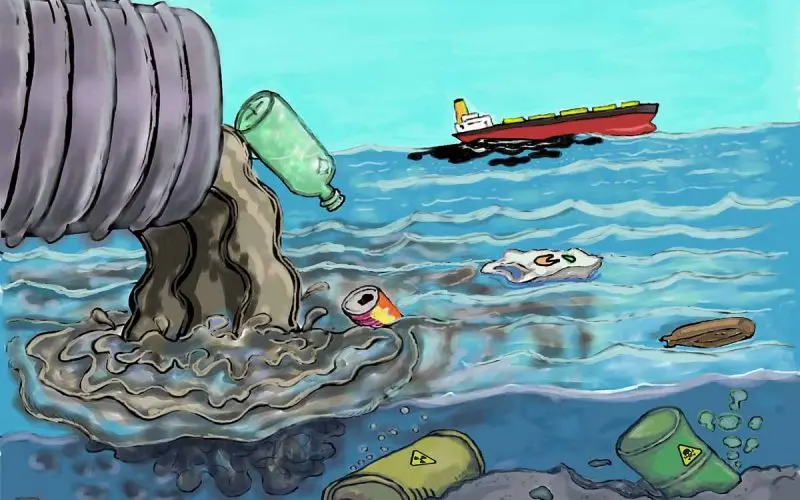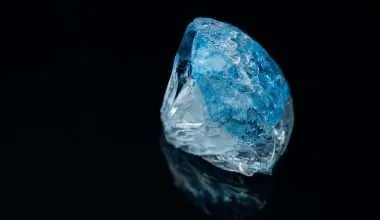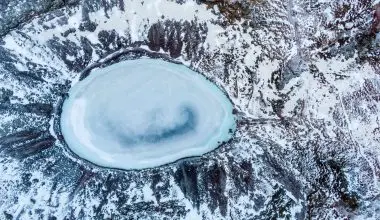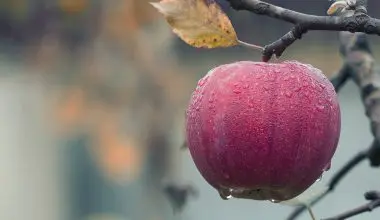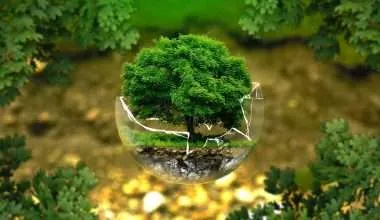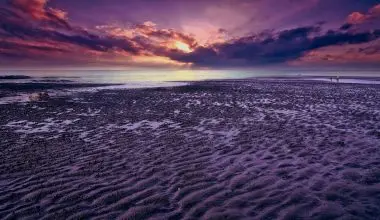Table of Contents Show
Two-thirds of Earth is water; just one-thirds is land where us humans and the terrestrial animals live in.
As the world’s population keeps on developing, individuals are putting regularly increasing weight on the planet’s water assets.
In other words; Our seas, streams, and other inland waters are being “pressed” by human exercises. Not pressed like they occupy less space, but in a way that the water quality is diminished.
And diminished water quality means water pollution.
Navigation:
What is Water Pollution? Definition
Methods of Measuring Water Quality
- Sewage Water Pollution
- Nutrient Pollution
- Wastewater Pollution
- Chemical Waste
- Radioactive Waste
- Oil Spills
- Water Pollution due to Plastics
- Invasive Alien Species
- Thermal Pollution
- Sediments in River Beds
- Acid Rain
Possible Solutions to Water Pollution
We realize that any form of pollution is a human issue. We believe that since it’s a recent occurrence in the planet’s history.
Before the First Industrial Revolution in 19th Century, individuals lived more in harmony with the natural environment. As industrialization spread throughout the world, so did the issues of environmental pollution.
When Earth’s population was small, nobody thought pollution could ever build up to be a difficult issue. It was strongly believed that the seas were too large to be polluted.
Today, with 7 billion people on the planet, it is now clear that there are limits to exploiting nature. Different forms of pollution, along with climate change and global warming, are signs that people have surpassed those limits.
Water pollution is such a serious problem that WWF stated,
“Pollution from toxic chemicals threatens life on this planet. Every ocean and every continent, from the tropics to the once-pristine polar regions, is contaminated.”
What is Water Pollution?
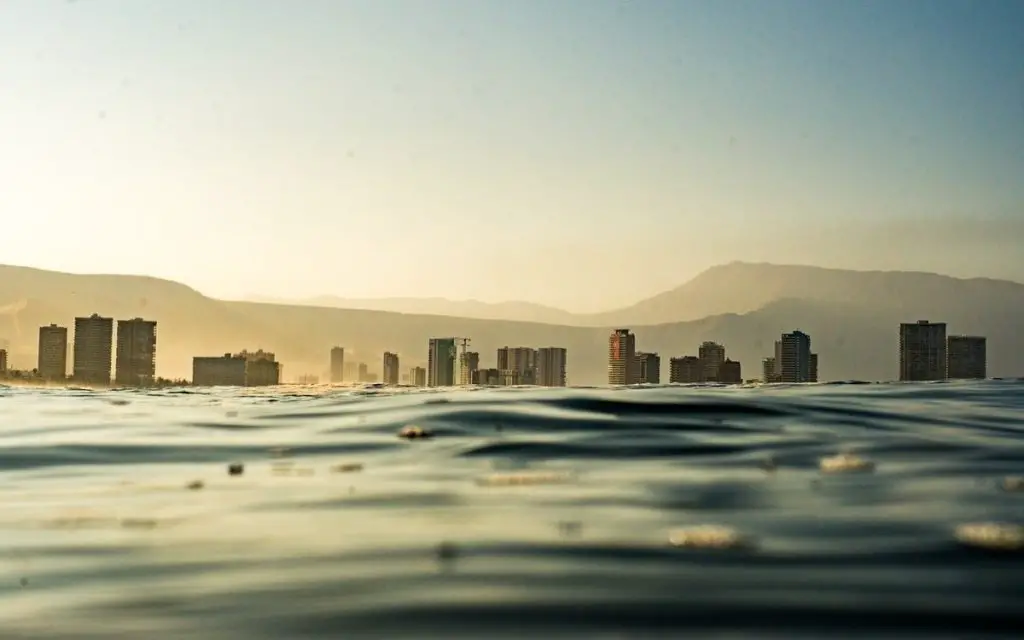
Water contamination can be characterized from numerous points of view.
Usually, it means at least one toxic substance (a pollutant) has increased its concentration in water to such a degree, that they cause issues for humans or animals on exposure.
Seas, lakes, waterways, and other inland waters can normally tidy up a small amount of contamination by scattering or diluting it without a problem. But when talking millions of gallons, it’s a bit different.
Let me give you an example.
Let’s say you poured some dark ink into a stream. The ink would rapidly vanish into the waterway’s large volume of clean water.
The ink would be there in the waterway. It would just be in such a low concentration, that you won’t see it.
At such low dimensions, the synthetic substances in the ink would not present any genuine issue.
However; If you emptied gallons of ink into a stream at regular intervals through a pipe, the waterway would rapidly turn dark.
The synthetic chemicals in the ink could, in all respects, rapidly affect the nature of the water. This would influence the strength of all plants, animals, and people whose lives depend on that stream of water.
In this way, water contamination is greatly linked with quantity of water pollutants.
The amount of a dirtying substance that is discharged and how large is the volume of water it is discharged into.
Just another example, skip ahead if you understood the concept.
A small amount of a harmful substance may have little effect when spilled into the sea from a ship. Yet, the same amount can have a lot greater effect drained into a lake or stream, where there is less clean water to scatter it.
Luckily, the harm is quite reversible as we’ll discuss ahead in solutions to water pollution.
P.S: Other forms of pollution are Air pollution and Soil Pollution.
Types of Water Pollution
Surface-water Pollution
When we think about Earth’s water assets, we consider enormous seas, lakes, and streams.
Water assets like these are called surface waters. The most visible sort of water pollution influences surface waters.
For instance, an oil spill from a tanker can influence a tremendous zone of the sea and could be visible on the surface of waters.
However, you’d be surprised to know that surface water is just a small fraction of Earth’s water.
Groundwater Pollution
A lot of water is held in underground structures known as aquifers. We can’t see those structures and only consider them when needed to.
Water put away underground in aquifers is known as groundwater. Aquifers feed our fresh-water sources (rivers and lakes) and supply most of our drinking water.
Even aquifers can get polluted. For instance; when weed killers are used on farms, gardens or backyards, they can channel into the ground.
Groundwater pollution is much more subtle than surface-water contamination, because we can’t see it happening. It is still a major issue.
In 1996, an investigation in Iowa in the United States found a large portion of the state’s groundwater wells polluted with weed executioners.
You may figure things would have improved from that point forward.
Sadly, two decades later, all that is truly changed is the name of synthetic chemicals we’re using. Today, new researches are still discovering weed executioners in groundwater, and in stressing amounts!
A recent report found glyphosate in 41 percent of 140 groundwater tests from Catalonia, Spain. Researchers argue on safety issues related to that.
Although, one thing’s certain. Such high concentrations of a chemical in a water source is never a good sign.
Surface waters and groundwater are the two types of water assets that get polluted. Similarly, there is another classification which divides water pollution on how it happens.
Sources of Water Pollution
In the event that contamination originates from a single place (source), it is known as point-source contamination. For example, a release pipe connected to an industrial facility.
Other examples of point source contamination include an oil slick from a tanker, wastewater release from a factory (processing plant), or somebody pouring oil from their vehicle down a water channel.
A lot of water contamination doesn’t happen from a single source, but rather from a wide range of distributed sources. This is called nonpoint source pollution.
Multiple factories releasing industrial waste down the same water stream would be an example of nonpoint-source pollution.
Still confused? Let me break it down.
At the point where point-source contamination enters nature, the spot most affected is generally the zone right around the source.
For instance; when a tanker mishap happens, the oil spill is focused around the tanker itself. And in proper sea conditions, the pollution level reduces as you move away from the tanker.
This is rarer to happen with non-point source contamination which, by definition, enters the earth from various sources without a moment’s delay.
You’ll find similar levels of contamination throughout the water body!
Sometimes, Pollution that enters the earth in one spot has an impact at quite a distance across the border. This is known as trans-boundary pollution. This can be applied to air pollution as well, since an air pollutant can cross borders carried by wind.
One model is the way radioactive waste released from atomic reprocessing plants (Nuclear energy plants) in England or France goes through the seas to their neighbors like Ireland and Norway.
Methods of Measuring Water Quality
There are two primary methods for estimating the quality of water.
The first one is to take water tests and measure chemical concentrations of toxins present in it.
Here’s one of the most sensitive water testing kits on Amazon. It comes with proper instructions to test your drinking water supply.
And that’s all the equipment for measuring water quality you need!
If the toxins are very risky or the concentration is large enough, we can view the water as dirtied or polluted.
Estimations like this are known as ‘concoction markers’ of water quality.
A second way to estimate water quality includes analyzing the fish, creepy crawlies, and different spineless creatures in the aquatic ecosystem.
If a wide range of kinds of animals can live in a stream, the quality is probably going to be excellent. If the waterway underpins no fish life by any means, the quality is clearly bad.
Estimations like these are called ‘natural markers’ of water quality.
Causes of Water Pollution
As we discussed, Pollution is a new development in world’s history, and most likely the result of human overpopulation.
This is why most of the water pollution occurs on land, dirty water drains from there into water-bodies. To be precise, 80% of the water pollution is caused by activities on land.
These activities have an almost immediate effect on water quality. The problem is, there are so many potential causes to water pollution that it may seem difficult and overwhelming to solve.
The best thing we can do is divide the causes, so we can fight them one at a time. Kind of how I did in this article.
1. Sewage Water Pollution
With billions of individuals on the planet, discarding sewage waste is a big issue.
As indicated by World Health Organization’s report in 2015;
2.1 billion individuals (28 percent of world’s population) don’t have access to safe drinking water, while 2.3 billion (30 percent of world’s population) don’t have appropriate sanitation (hygienic toilets).
Even though there have been extraordinary achievements in tying down access to clean water, little advancement has been made on improving worldwide sanitation over the past ten years.
Sewage transfer affects society’s environmental health and causes water-related diseases. For example, diarrhea murders 525,000 kids under five years of age every year.
In developed countries, people usually have flush toilets that remove sewage waste rapidly and clean it from their homes. However, the issue of sewage transfer does not end there.
When you flush the can, the waste needs to go somewhere. Even after sewage treatment, there is still some waste left to discard.
Sometimes sewage is drained untreated into the ocean. Until the mid-1990s, around 5 million tons of sewage was dumped by a freight boat from New York City every year.
Unfortunately, even in highly developed countries, the act of dumping sewage into the ocean continues.
In mid-2012, the modest island of Guernsey chose to keep dumping 16,000 tons of crude sewage into the ocean every day.
In principle, sewage is a natural substance that can biodegrade in the earth without a problem. 90 percent of sewage is water!
Practically speaking, sewage contains a wide range of different synthetics. These range from pharmaceutical medications to paper, plastic, and other forms of solid waste people flush down their toilets.
When someone gets infected, their sewage (excretion) carries those infections into nature. It is possible to get infected with infections like hepatitis, typhoid, and cholera from others coming in contact with infected waterway and ocean water afterwards.
This is because the micro-organisms that cause the disease are released into the nature when infected human waste flushes down the toilet.
2. Nutrient Pollution
Reasonably treated and utilized in limited amounts, sewage can be used as manure.
It returns vital supplements to the earth, for example, nitrogen and phosphorus. Plants and animals require these nutrients for development.
The problem arises when sewage is regularly discharged in huge amounts which, a common habitat can’t handle.
Fertilizers or pesticides used by farmers on agricultural land can seep into groundwater, or be washed by rain into nearby surface waters. They bring nutrients and add to the fertilizing impact of sewage water.
Deforestation increases surface water run off and soil erosion.
Read more: Nutrient Pollution; Causes, Effects and Solutions
Together, sewage and manures can cause a huge increase in development of plant growth or tiny fish that overpowers the aquatic ecosystem in seas, lakes, or streams.
The growth in phytoplankton is described as Harmful Algal Bloom (otherwise known as HAB or red tide, since it can turn the water red). The process by which algal bloom occurs is known as cultural eutrophication.
Harmful Algal Bloom is destructive because high phytoplankton masses extract oxygen from the water. This executes different types of life, forming a ‘Dead zone’.
The Gulf of Mexico has one of the world’s largest ‘Dead Zones’. Each late spring, it develops to a zone of around 5000–6000 square miles (15000 square kilometers), about the size of Connecticut.
3. Wastewater Pollution
What is Wastewater?
Wastewater is the byproduct of all activities that require the use of water. These activites can be household, commerical or industrial in nature. They convert water, that is safe to use, into water that isn’t.
Read More: Wastewater Pollution; Causes, Effects and Solutions
A couple of facts represent the size of issues that waste water pollution can cause.
- Around half of all ocean pollution is brought about by sewage and wastewater.
- In the United States alone, around 400,000 industrial facilities take clean water from waterways and release dirtied water in return.
Anyways, there have been great enhancements in wastewater treatment in recent years.
Since 1970, the Environmental Protection Agency (EPA), in United States, has spent $70 billion in improving water treatment plants.
These plants serve clean drinking water to 88 percent of US population!
Industrial processing plants (any industry) are point sources of water pollution, but majority of water is contaminated by individuals from nonpoint sources. These are multiple sources that contribute to converting clean drinking water into wastewater.
Examples of Wastewater Sources
A large number of people pour chemicals down their sinks or toilets.
Even detergents used in laundry machines or dishwashers end up in water streams and oceans.
A great deal of polluted water enters nearby lakes and rivers from highway runoff, mainly during rainy seasons.
Expressways are regularly exposed to dangerous chemicals. These range from spilled fuel and brake liquids to bits of worn tires and fume outflows are present on the surface of the highway.
When it rains, these synthetic compounds wash into channels and streams. It’s common for summer rainstorms to wash lethal synthetic compounds into nearby streams.
These compounds are so high in quantity, they slaughter huge quantities of fish instantly.
Did you know? A large city’s roadway spillover in a single year spills as much oil, into water bodies, as an ordinary tanker spill.
Some expressway spillover flees into channels; others can contaminate groundwater. It can also make a puddle by the street, making it progressively dangerous as years pass by.
4. Chemical Waste
Detergents are moderately gentle substances. At the extreme end, there are some exceptionally-harmful synthetics like Poly-Chlorinated Biphenyls (PCBs).
PCBs were once widely used to produce electronic circuit sheets, oils, paints, glues and whatnot. We quickly caught up to realize the dangerous effects of that harmful chemical. EPA banned the production of PCBs in 1979.
However, before being banned, they had enormous production! An expected half a million tons of PCBs were released into the earth, damaging environment throughout the 20th century.
In a great case of trans-boundary pollution, hints of PCBs were found in birds and fish in the Arctic. Oceans helped PCBs travel such long distances!
Even though PCBs are broadly restricted now, their effects will be felt for a long time since they have a long lifespan.
Another poisonous chemical that causes water pollution are heavy metals. These metals include Lead, Cadmium, and Mercury among others.
Lead was once generally utilized in fuel (petroleum). However, Lead use is now banned in many nations.
Mercury and Cadmium are still utilized in batteries (however there are a few brands presently which utilize different metals).
Just a few years ago, a toxic chemical called tributyltin (TBT) was being used in paints to shield boats from the impact of waves. TBT was quickly found to be a toxin. Boats painted with TBT were doing as much harm to the seas as the seas were doing to the vessels.
The best known case of heavy-metal contamination in the seas occurred in 1938.
A Japanese processing plant released a lot of mercury metal into Minamata Bay, polluting the fish stocks there. It took 10 years for authorities to find and expose this issue!
At that point, many individuals had eaten the fish and around 2000 people were harmed. Some had heavy metal-poisoning to the point that they passed away or left with permanent damage.
5. Radioactive Waste
Individuals see radioactive waste with incredible caution — and in light of current circumstances, it should be that way.
At very high levels of hazardous waste exposure, a person can experience nausea and vomiting few hours after exposure and even die later. This is known as ‘radiation sickness’ or ‘acute radiation syndrome’.
In lower concentrations, it can cause different types of cancers and cardiovascular disease.
The greatest sources of radioactive pollution in Europe are two industrial facilities. These are responsible for reprocessing waste fuel from two atomic power plants:
- Sellafield on the North-West bank of Britain
- Cap La Hague on the North shore of France.
Both release radioactive wastewater into the ocean. Nations like Norway, which lie downstream from Britain, get a lot of radioactive contamination from Sellafield.
6. Oil Spills
When we consider water pollution in the oceans, tremendous dark oil spills regularly spring to mind. You’d be surprised to know these mishaps are a very small part of all water pollutants entering our seas.
Just 12 percent of oil that enters the seas comes from tanker mishaps.
More than 70 percent of oil contamination comes from day to day processes or from individuals pouring oil down channels on land.
Nonetheless, what makes tanker spills so dangerous is the huge amount of oil they discharge in just a few minutes. High amounts of oil in one small region of ocean is bound to create problems for the marine life.
The greatest oil slick as of late happened when the tanker Exxon Valdez leaked in Prince William Sound in Alaska in 1989.
Around 12 million gallons (44 million liters) of oil were discharged in 2015 — enough to fill your lounge multiple times over!
Assessments of marine animals executed in the spill were more than 3000 Sea Otters and 250,000 ocean birds. A few billion salmon and herring eggs are estimated to have died as well.
P.S: Oil spills aren’t the only way fossil fuels cause water pollution. Burning fossil fuel releases greenhouse gas emissions which cause acid rain.
7. Water Pollution due to Plastics
If you’ve taken part in beach-cleaning, you’ll realize that plastic is the most well-known substance that ends up on the shore.
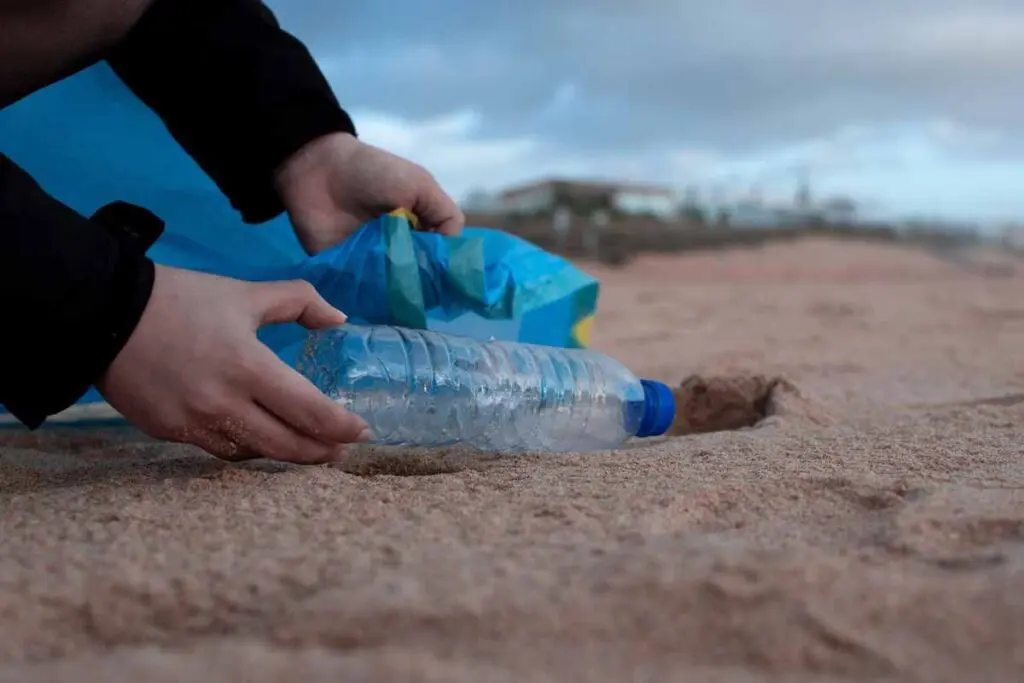
There are three explanations behind why plastics are most commonly found on the beach.
Plastic is a the most widely known materials, used for making a number of objects ranging from apparel to furniture.
Plastic is light and floats effectively so it can travel on the ocean surfaces.
Most plastics are non-biodegradable. This means products like plastic container tops can persist in waters for quite a while.
Did you know? A plastic container can last 450 years in the sea and a plastic fishing line can last as long as 600 years.
While plastics are not as harmful as toxic chemicals, they still do present a risk to seabirds, fish, and other marine animals.
For example, plastic fishing lines left behind in the ocean can choke or stifle fish. This is known as ghost fishing.
A study in 2015 concluded that there was plastic in guts of 90% of all seabird species living then. They had eaten plastic by mistaking it for food.
Some believe 99% of all seabirds will have ingested plastic by 2050. That’s an alarming concern!
8. Invasive Alien Species
Usually when one thinks about water pollution they think, oil waste, plastics and toxic heavy metals but pollution can also be biological.
Alien species, sometimes known as invasive species, are taken from their native habitat and introduced into the habitat of other species.
An example of invasive species would be the alien algae, Caulerpa Taxifolia, which has invaded the Mediterranean sea.
9.Thermal Pollution
Warm water released from factories raises the water temperature of oceans.
This reduces the oxygen dissolved in waters, which harms its ability to support marine life. This is known as thermal pollution.
10. Sediments in River Beds
Another source is the dispersion of fine-course powders known as sediments. These small grains flow from rivers into seas.
Building dams reduces flow of sediments into the sea and also decreases nutrients flowing to coastal marine life.
However, for reasons like construction, large amounts of sediments get concentrated in water bodies.
These grains get stuck in fish gills, thereby suffocating them.
Construction firms in developed countries are making efforts to avoid such construction materials. Awareness in third-world countries like India still needs to be raised.
11. Acid Rain
Air pollutants like carbon dioxide, sulfur dioxide and nitrogen oxides can go up into the clouds and come down in the form of acid rain.
These pollutants mix with water and form weak acids; carbonic acid, sulfuric acid and nitric acid (slightly stronger) respectively. The rain water dilutes these acids and that’s why acid rain has a pH around 4.3 [Normal rain pH: 5.5].
Acid rain entering seas, rivers and lakes and causing water pollution. This type of Water Pollution is called Atmospheric deposition.
Here’s another example of atmospheric deposition.
Heavier chemicals like mercury (released by burning fossil fuels) descend back on water surfaces and get consumed by fishes.
Effects of Water Pollution
A few people trust that pollution is the fault of us humans.
Some believe pollution to be necessary if we are to progress. Their argument is that we need to have manufacturing plants, urban communities, ships, vehicles, oil, and seaside resorts to progress.
Luckily, not everyone agrees. One reason individuals raise their voice against pollution is because it has major effects on the environment. These economic activities are simply not worth the expense of pollution effects we have to bear.
Let me prove to you how water pollution has affected our lives and continues to do so.
Take oil slicks, for example. Oil spills can occur if tankers are not well-built to endure harsh seas.
Anyways, cost-saving by cutting corners in tanker quality brings a huge environmental cost when an oil slick happens.
The oil spilled in oceans can appear on shorelines, destroy the marine system, and seriously influence the travel industry.
The primary issue is that the general populations who bear the expense of the spill (commonly a little community that lives by the beach) are not the general population who caused the issue (the general population who made and operate the tanker).
However, everybody who puts gas (oil) into their vehicles practically contributes to the issue.
So oil slicks are an issue for everybody, not simply individuals who live by the coast and tanker operations.
Sewage is another genuine case of how pollution can affect every one of us.
Sewage released into the ocean can appear on shorelines and can be dangerous to our health. Individuals who wash or surf in the water can become sick if they come in contact or swallow contaminated water.
Sewage can have other unsafe impacts as well. It can harm shellfish, (for example, cockles and mussels) that grow close to the shore.
Individuals who eat shellfish from polluting waters experience an intense—and in some cases deadly—ailment called paralytic shellfish poisoning.
Shellfish is not found along shores anymore. This is because shores have become excessively polluted with sewage or harmful chemicals that have released from the land close-by.
Water Pollution hurts nature slowly and deeply.
Humans are highly dependent on nature. The environment isn’t something inaccessible and separate from our lives.
It is anything but a pretty shoreline many miles from our homes or a wild scene that we see just on TV.
The earth is is responsible for everything that provides us with health and life. Damaging the earth decreases the quality of our own lives—and that is the reason pollution should matter to us all.
Possible Solutions to Water Pollution
Well there’s no shortcut to defeat water pollution. Generally, there are three ways that we could reduce water pollution.
Education, Laws and Economics are three tactics we can use as water pollution solutions, but they need to be used together.
For example, people would abide more by environmental laws if they knew how those laws help the environment.
Education
To solve a problem, you gotta know it first.
Making individuals know about the issue is the first step to solving a problem.
In the mid-1990’s, when surfers on Britain shores became increasingly sick sick from water contaminated with sewage. They shaped an Environmentalist group called Surfers Against Sewage to constrain governments and water organizations to get it together.
Individuals who are aware about ocean pollution, they have started cleaning up world’s polluted beaches frequently. They even gather to arrange group beach-cleaning sessions.
Fishermen can’t catch fish anymore. They have battled for harder punishments against processing plants that empty polluted water into our waterways.
Increased public awareness can make quite a difference.
Laws
One of the most serious issues with water contamination is its ability to cross borders and become a trans-boundary form of pollution.
Numerous streams cross nations, while oceans range entire continents.
Contamination released by factories in a single nation with poor ecological norms can cause issues in neighboring developed countries, even when they have harder laws and higher principles.
Environmental laws can make it harder for individuals to pollute the environment, yet to be extremely effective they need to work over national and international borders.
This is the reason that there are international laws that are applicable on ocean pollution.
Laws to stop water pollution internationally include:
- 1982 UN Convention on the Law of the Sea (signed by over a 100 countries),
- 1998 OSPAR Convention for the Protection of the Marine Environment of the North East Atlantic,
- The London convention protocol in 1972 (modernized in 1996 and brought into action by 87 states in 2006).
The European Union has environmental laws involving water-protection that are essentially followed by all of its member states. They include the 1976 Bathing Water Directive, which involves better quality of the water used for recreation purposes.
Some countries have their own laws regarding water pollution. The US has the 1972 Clean Water Act and the 1974 Safe Drinking Water Act brought about by the efforts of EPA.
Economics
Most ecological specialists agree that the most ideal approach to handle pollution is through something many refer to as the polluter pays rule.
This implies whoever causes contamination needs to pay to clean it up, somehow. Polluter pays can work in a wide range of ways.
It could mean that tanker proprietors buy insurance that takes care of the expense of oil slick cleanups, for instance.
It could also mean that customers pay extra for single-use plastic grocery bags (as is currently normal in Ireland nowadays).
This is to promote recycling and not just throwing away plastic.
Eventually, the polluter pays guideline is intended to discourage individuals from polluting. This makes it more affordable for them to carry out daily activities in an environment-friendly manner.
Better Tomorrow
This tells you about how you can make a difference to stop water pollution.
Life is at last about decisions—as is pollution. We can live with sewage-strewn shorelines, dead waterways, and fish that are too harmful to even think about eating.
Or on the other hand we can cooperate to keep the earth clean so the plants, creatures, and individuals who rely upon it stay sound.
We can make individual choices to help decrease water pollution. For instance, by utilizing environment-friendly detergents, not pouring oil down channels, lessening pesticides, i.e. behavioral changes.
We can make network moves as well, by assisting on shoreline cleans or litter picking to keep our streams and oceans more clean.
Also, we can make a move as nations to pass laws that will make pollution harder and the world cleaner. Cooperating, we can make pollution a smaller problem—and the world a better place to live in.
